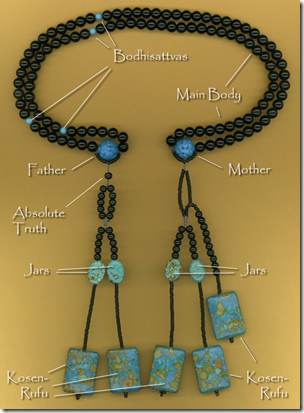 In the practice of Nichiren Buddhism, we hold juzu beads in our hands while reciting Gongyo and chanting Diamoku.
In the practice of Nichiren Buddhism, we hold juzu beads in our hands while reciting Gongyo and chanting Diamoku.
There are 108 beads in the main body, signifying the 108 Earthly Desires.
The 4 smaller beads in the main body represent the 4 Great Bodhisattvas of the Earth … Jogyo, Muhengyo, Jyogyo, and Anryugyo.
The 2 large beads at each end of the main body, are the “parent” beads. The “mother” bead, representing “mystic” is on the side with 3 dangles, and is placed over the middle finger of the right hand. The “father” bead, representing “law” is on the side with 2 dangles, and is placed on the middle finger of the left hand.
We cross the beads in the middle, which shows our oneness with THE LAW. Also, we cross the beads so our benefits do not fall through our hands and lives. By placing the beads on our hands this way, we are accepting the reality that Buddhahood exists within our lives.
When we press our hands together while we hold our juzu beads, our 10 fingers represent the 10 Worlds which fuse together simultaneously in the life of a Buddha, our lives. Our life is now one with the Mystic Law!
The one small bead that sits below the “father” bead, represents Absolute Truth.
Prior to Nichiren Buddhism, there were only 2 dangles on each end of juzu beads. The third dangle, consisting of 10 beads and a “Kosen-Rufu” bead, on the side of the “mother” was added, actually tied on, to signify Nichiren Buddhism and distinguish it from other Buddhist sects.
On the remaining 4 dangles, there is a differently shaped bead part way down each string. This bead is called the “jar” bead and holds the benefits of our practice.
The 5 larger beads at the bottom of each dangle are the “Kosen-Rufu” beads, and represent our desire to spread Nichiren Buddhism, Kosen-Rufu, throughout the World.
My huge thanks are due to my lovely friend Lily Rose of Myoho Beads for researching the meanings of the individual beads and for allowing me to use her explanation.
As Lily Rose says on her site, be careful buying juzu beads on line. Use this description or the juzu purchased in SGI bookstores as a guide. Make sure the beads you purchase have been created in an ethical and politically correct manner. Sorry to say, but many are not.
If you would like to learn more about chanting, this link will take you to a very informative video produced by SGI.

Apr 01, 2014 @ 12:54:33
Amazing!!!!!